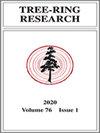Analysis of the Climate Signal in Subannual Width Measurements of Pinus nigra Tree Rings in Kastamonu Province, Turkey
IF 0.7
4区 农林科学
Q3 FORESTRY
引用次数: 0
Abstract
ABSTRACT Black pine (Pinus nigra) is a widely distributed tree species across southern Europe and Asia Minor. This article summarizes a dendroclimatological study of subannual P. nigra ring width conducted during an international summer course “Tree Rings, Climate, Natural Resources, and Human Interaction” in 2022. Increment cores were collected from 15 young (oldest 105 years) P. nigra trees in the Araç Forest District in Kastamonu Province, Turkey. Site chronologies of earlywood (EW) and latewood (LW) width were developed to investigate climatic signals using correlation analysis. Results show that EW and LW chronologies are significantly correlated with one another (r = 0.56, n = 105, p < 0.001) and positively correlated with precipitation in the months April–September of the growth year. The month of strongest correlation shifts from April for EW to July for LW. Analysis of seasonally aggregated climate data further shows that EW but not LW responds positively to precipitation in the preceding summer (July–September). These results suggest that future tree-ring studies aimed at tree-growth impact of climate change in the Black Sea region of Turkey exploit the climate signal in subannual ring widths of P. nigra.土耳其Kastamonu省黑松年轮宽度测量的气候信号分析
黑松(Pinus nigra)是一种广泛分布于南欧和小亚细亚的树种。本文总结了在2022年“树木年轮、气候、自然资源和人类相互作用”国际夏季课程中对黑桫椤年轮宽度进行的树木气候学研究。从土耳其Kastamonu省Araç林区的15棵幼树(最老105年)中收集了增加岩心。利用相关分析,建立了早木(EW)和晚木(LW)宽度的遗址年表,以研究气候信号。结果表明:生长期4 ~ 9月EW和LW年代学呈显著相关(r = 0.56, n = 105, p < 0.001),且与降水量呈正相关。东西向相关性最强的月份由4月移至7月。季节汇总气候资料分析进一步表明,在前一个夏季(7 - 9月),EW对降水有显著的响应,LW对降水没有显著的响应。这些结果表明,未来针对土耳其黑海地区气候变化对树木生长影响的树木年轮研究可以利用黑松年轮宽度的气候信号。
本文章由计算机程序翻译,如有差异,请以英文原文为准。
求助全文
约1分钟内获得全文
求助全文
来源期刊

Tree-Ring Research
农林科学-林学
CiteScore
2.40
自引率
12.50%
发文量
15
审稿时长
>36 weeks
期刊介绍:
Tree-Ring Research (TRR) is devoted to papers dealing with the growth rings of trees and the applications of tree-ring research in a wide variety of fields, including but not limited to archaeology, geology, ecology, hydrology, climatology, forestry, and botany. Papers involving research results, new techniques of data acquisition or analysis, and regional or subject-oriented reviews or syntheses are considered for publication.
Scientific papers usually fall into two main categories. Articles should not exceed 5000 words, or approximately 20 double-spaced typewritten pages, including tables, references, and an abstract of 200 words or fewer. All manuscripts submitted as Articles are reviewed by at least two referees. Research Reports, which are usually reviewed by at least one outside referee, should not exceed 1500 words or include more than two figures. Research Reports address technical developments, describe well-documented but preliminary research results, or present findings for which the Article format is not appropriate. Book or monograph Reviews of 500 words or less are also considered. Other categories of papers are occasionally published. All papers are published only in English. Abstracts of the Articles or Reports may be printed in other languages if supplied by the author(s) with English translations.
 求助内容:
求助内容: 应助结果提醒方式:
应助结果提醒方式:


